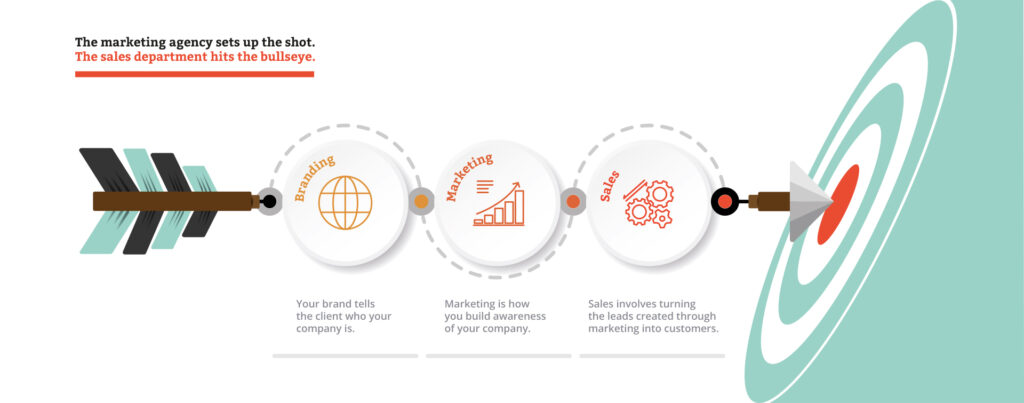In our experience, clients often confuse marketing, branding, and sales. Many small-and-medium-sized businesses assume that marketing and branding are equivalent to sales. While these three functions are related, they are discrete.
Branding, Marketing, and Sales Defined
Before you get bogged down in terminology, let’s take a minute to define each of these categories.
Branding
What is branding? Branding is who your company is and what you represent. It’s the process of shaping your company’s image in your customers’ minds. Your company’s visual identity, mission, and core values are all part of your brand. Your company’s brand establishes its reputation and is integral to its long-term success.
Marketing
What is marketing? Marketing is how you build awareness of your company. It’s all the activities used to promote your product, service, or business. It can include your website content, search ranking, advertisements, promotions, social media, and more. These marketing tactics begin to guide your future clients down the road of the buyer’s journey. However, even the best marketing can’t generate sales if your product or service doesn’t deliver on its brand promise or poor customer service.
Sales
What are sales? Sales are the transaction, revenue generated, and conversions from goods or services to profit. It involves converting leads created through marketing and the sales funnel into customers.
Your Marketing Agency’s Responsibilities — And Yours
For a fruitful working relationship, it’s important to know where each entity’s responsibilities lie and who is accountable for each function. Many marketing agencies, like LuckyTamm Digital Marketing, coordinate the activities that set the stage for sales. The sales department must then manage the clients’ experiences and close the sale using their product expertise. In short, the marketing agency sets up the shot, and the sales department hits the bullseye.

Let’s look at an example to see how this works in practice: Toyota has built a brand based on reliability and quality. A customer may be familiar with this brand when he/she sees a Superbowl commercial that reminds them of this status and inspires them to visit a car dealership to learn more. Once the customer walks in the door, the salespeople become responsible for teaching the customer about the latest safety features, gas mileage, and stereo system in the Corolla.
If you’re curious about how whether your marketing is working (e.g., driving sales leads), it’s vital you employ a Customer Relationship Management (CRM) system. This will allow you to manage your customers’ data and how they interact with your company. This includes tracking how your customers heard about your business, for example through an Internet search, social media, or an ad.
Together, these layers of approaches drive consumer behavior. As the management theorist Peter Drucker said, “what gets measured gets managed.” The more you measure your customer interactions, including referrals, the better you’ll be able to manage the results.
2022 Marketing Trends and Sales Tactics
As the marketplace has changed, so too have marketing and sales tactics. In the 1970s and ’80s, marketing was driven by the philosophy of the four Ps: product, place, promotion, and price. However, with the emergence of the Internet, people have changed their buying habits and the way they consume information.
Today, marketing is driven by the four Cs:
- Customer (wants and needs)
- Cost (to satisfy those needs)
- Communication (who is influencing you to make a purchase)
- Convenience (to buy).
This shift has placed greater emphasis on serving the consumer, rather than the prowess and immanent appeal of the business.
Sales trends also point to greater customer service. Clients have higher expectations than ever before. Qualtrics, the leading experience management software, predicts that companies who can identify experience gaps in the marketplace will be successful. For example, rideshare services like Lyft and Uber identified an experience management gap in the taxi industry. These companies made it easier to hail a ride, easier to pay, and more comfortable to ride. Now, they’ve supplanted taxis. If sales teams can manage experiences, they will meet or exceed revenue goals.
How LuckyTamm Digital Marketing Can Help
Our team members can help you better understand the differences between branding, marketing, and sales so that you can formulate clear objectives and expectations for each function. If you’re a small-to-medium-sized business that relies on word-of-mouth marketing and wants to expand, we can help. Connect with us, today!

